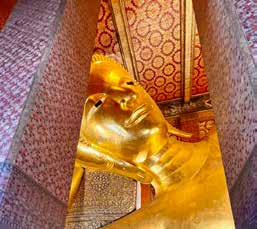Cruising Asia in the Wake of Covid

Lisa Spiller
With Asia now open to U.S. travelers, we spontaneously booked one of the first cruises to sail Southeast Asia since the Covid pandemic. With visions of a Singapore Sling in mind as we touched down in Singapore Christmas week, we checked into the iconic Raffles Hotel for two nights.
Our private guide Gee Soo from Hello Singapore tours greeted us in our lobby and escorted us on a jaw-dropping exploration of award-winning architecture, multi-cultural neighborhoods and street food. With Gee Soo’s guidance, we biked, walked, took busses, subways, canal boat and gondolas to Gardens by the Bay, Marina Bay, Boat Key, Clarke Quay, Sentonsa Island, and we indulged in the Hawker Markets which have been named a UNESCO Intangible Cultural Heritage of Humanity. Hawker Markets are street food markets featuring local favorites like Hainanese chicken rice, chili crab, fish head curry, wok fried noodles and oyster cakes.
 To punctuate our visit, we slid into the Long Bar at Raffles Hotel and indulged in Singapore Slings. The city nation of Singapore is as cosmopolitan as it is exotic. Everyone speaks English, public transportation is easy, the city is immaculate, and streets are safe.
To punctuate our visit, we slid into the Long Bar at Raffles Hotel and indulged in Singapore Slings. The city nation of Singapore is as cosmopolitan as it is exotic. Everyone speaks English, public transportation is easy, the city is immaculate, and streets are safe.
We boarded the Seabourn Ovation for their first cruise out of Singapore in years, and within this context, we devoured each exotic port of call like starved wanderlusts and gave thanks as each new bucket list adventure unfolded.
Seabourn’s first stop was Koh Kood, Thailand, a barefoot beach island escape. Languid blue waters lapped at palm-laced shores while we swung from branches sipping Malibu Rum & coconut water out of fresh green coconuts. Officers dressed in epaulets and dazzling whites waded into the Sea of Thailand with bottomless bottles of French champagne, ceremoniously crowned a surfboard with a bucket of caviar and doled out lavish portions to my fellow cruisers and I as we swarmed the bay. Locals provided Thai massages under the shady palms at the water’s edge to the sound of symphonic surf.
 Relaxed and restored, we arrived in Bangkok, Thailand the next day. The port is actually 90 minutes from the city of Bangkok, so we maximized our overnight visit by booking a two-day private guided tour, packed overnight bags and stayed in a luxury hotel on the Chao Praya river in the heart of the city.
Relaxed and restored, we arrived in Bangkok, Thailand the next day. The port is actually 90 minutes from the city of Bangkok, so we maximized our overnight visit by booking a two-day private guided tour, packed overnight bags and stayed in a luxury hotel on the Chao Praya river in the heart of the city.
Elaborate brightly painted Buddhist temples were the star attraction at every market, neighborhood, palace and family home. We boarded motorized tuk tuks for a whirl around the city and visited the Emerald Buddha at the Royal Palace, the Golden Buddha, and the most sacred of all, Wat Pho, the 150 ft long Reclining Buddha. Buddha is omnipresent in Thailand, as are the monks, who are considered the messengers to Buddha. Monks draped in orange occupied temples and wandered streets accepting donations of flowers and food in exchange for blessings.
The Thai love beauty and believe that if you are surrounded by beauty, you have a beautiful life. Flower markets and stalls line city streets selling flower garlands of marigolds and jasmine for the monks and for wearable beauty.
Staples in every Thai diet are banana, coconut, dragon fruit, mango, and rice. We enjoyed traditional multi-course Thai meals featuring spicy shrimp and noodles, chicken satay, rice, curried vegetables, and during dinner on the river, were mesmerized by elaborately costumed Thai Dancers showcasing the art that every Thai toddler learns as a matter of tradition.
 Daily market visits are as much a part of Thai lifestyle, as is Buddha. The markets in Bangkok were EPIC.
Daily market visits are as much a part of Thai lifestyle, as is Buddha. The markets in Bangkok were EPIC.
The Damnoen Saduak Floating Market is among the best-preserved authentic attractions of Thailand and an unforgettable experience. We boarded a canopied wooden longboat and motored through canals brimming with hawkers floating in canoes piled with fruits, vegetables, carved wooden utensils, silk saris, cashmere scarves, coolie hats, sweets, dried fish, and orchid plants. We haggled for teak inlaid chopsticks, wooden bowls, silk boxer shorts, cashmere scarves, woven purses, cotton shirts and coconut candy and came home with bags of memories.
The Maeklong Railway market is a traditional Thai market with smelly fish and exotic fruits and vegetables, but what makes it so unique is that the market stalls are built right on top of the train tracks. When we heard the whistle of the oncoming train blow, all hawkers pulled their Baskets, buckets and tables off the tracks, dismantled their tents and squabbled with oblivious tourists before the train snaked its way through the market. It was organized chaos with a lot of disputation, and the speed and proximity of the train as it shimmied by only inches from my nose was moderately alarming. Almost like a boomerang effect, when the train stopped, the market stalls were then quickly and methodically erected again within 60 seconds.




Leave a Reply
Want to join the discussion?Feel free to contribute!